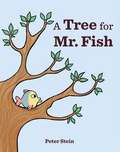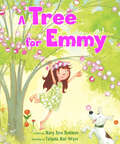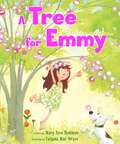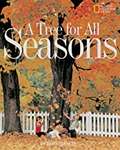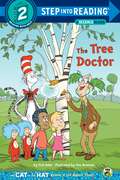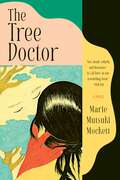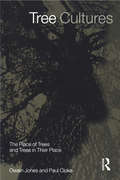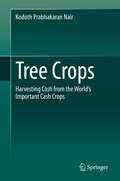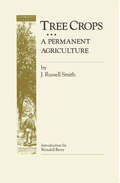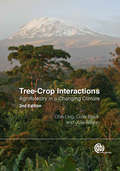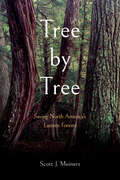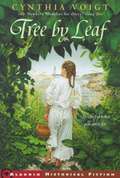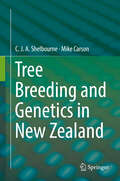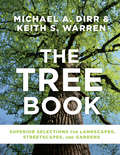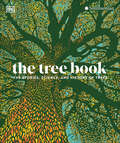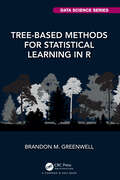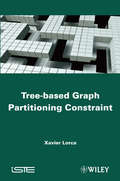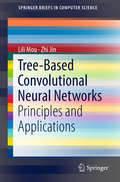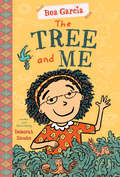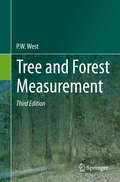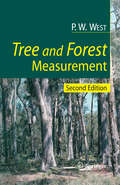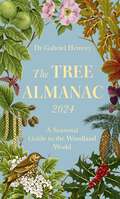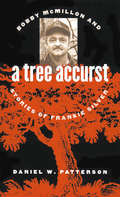- Table View
- List View
A Tree for Mr. Fish
by Peter SteinIn this humorous and heartwarming picture book, Mr. Fish refuses to share his tree with Bird and Cat—until he learns that making friends is more rewarding than losing them.Bird and Cat meet in a tree. But someone already lives in this tree—Mr. Fish. And he does not want to share. After Bird and Cat leave, Mr. Fish discovers that it’s actually pretty boring to sit in a tree all by yourself. Getting Bird and Cat back—along with Mr. Fish’s old friends from the sea—is going to require some real work. And Mr. Fish is already having a tough time, because fish aren’t supposed to be on land in the first place. Author-illustrator Peter Stein has created a quirky, hilarious take on the challenges and rewards of friendship—and being a fish out of water—in this unforgettable picture book that feels like a rediscovered classic.An Imprint Book
A Tree for Emmy
by Mary Ann RodmanA spirited young girl struggles to get a much-loved mimosa tree for her birthday in this delightful, multigenerational story, ideal for Arbor Day and Earth Day!Emmy loves trees. She loves oak trees with acorns. She loves pine trees with cones, and willow trees with swishy branches. But best of all, Emmy loves the mimosa tree that grows in her grandmother's pasture.So when Emmy decides she wants a mimosa tree of her own for her birthday, she is saddened to learn many garden stores only sell ornamental trees like plum or pear or tulip trees. Emmy is crushed―until she discovers that the answer to her problem is growing right before her eyes!Mary Ann Rodman's joyful story—packed with environmental, independence, and problem-solving themes—will appeal to nature- and tree-lovers as well as those seeking great spring read alouds. Illustrator Tatjana Mai-Wyss's whimsical watercolor and collage artwork captures Emmy's exuberant personality and the story's hopeful ending.
A Tree for Emmy
by Mary Ann RodmanEmmy loves the mimosa tree in her grandmother's yard and asks for one for her birthday, only to find that stores do not sell wild trees.
A Tree for All Seasons
by Robin BernardA maple tree goes through many changes over the course of the year. It even produces sap that people turn into maple syrup. This book not only answers questions about how trees work and why seasons change, but it also invites the reader to observe and enjoy nature and its many wonders.
Tree Fever
by Karen Hood-CaddyThe life of fiftyish Jessie Dearborn takes an unexpected turn when a ruthless developer threatens to cut down century-old trees in her small northern town in order to build a condominium. Surprising even herself, she steps in front of a chainsaw to defend the trees she loves. As the fight to save the trees intensifies, a group of gutsy, quick-witted older women joins the battle and explodes the issue into the newsmedia. At this turning point in her life, a native man helps Jessie by teaching her to trust her own instincts. Passion erupts between them and Jessie discovers a middle-aged sexuality as hot as the midday sun. Like a Group of Seven painting, Tree Fever is a love affair with nature, its wisdom, raw colours and elemental beauty.
The Tree Doctor (Fountas & Pinnell Classroom, Guided Reading)
by Jacqueline Adams Craig OrbackNIMAC-sourced textbook
The Tree Doctor (Step into Reading)
by Tom Brannon Tish RabeWhen Sally and Nick's maple tree won't grow, the Cat in the Hat knows who to call: Dr. Twiggles, who suggests they inspect its roots. A trip underground in the Thinga-ma-jigger is undertaken, and sure enough, the maple tree needs water (which Things One and Two procure in ridiculous overabundance) and sun (which the Cat supplements with a Brighta-ma-lighter). But as for getting syrup from the young sapling? That will take some 40 years! Written specifically for children learning how to read with help, this Step into Reading book is based on an episode of the hit PBS Kids' TV show The Cat in the Hat Knows a Lot About That! It is perfect for springtime reading, Earth and Arbor Day celebrations--and yes, even pancake breakfasts!
The Tree Doctor: A Novel
by Marie Mutsuki MockettA startling, erotic novel about the need to balance care for others with care for one’s selfWhen the unnamed narrator of Marie Mutsuki Mockett’s stirring second novel returns to Carmel, California, to care for her mother, she finds herself stranded at the outset of the disease. With her husband and children back in Hong Kong, and her Japanese mother steadily declining in a care facility two hours away, she becomes preoccupied with her mother’s garden—convinced it contains a kind of visual puzzle—and the dormant cherry tree within it.Caught between tending to an unwell parent and the weight of obligation to her distant daughters and husband, she becomes isolated and unmoored. She soon starts a torrid affair with an arborist who is equally fascinated by her mother’s garden, and together they embark on reviving it. Increasingly engrossed by the garden, and by the awakening of her own body, she comes to see her mother's illness as part of a natural order in which things are perpetually living and dying, consuming and being consumed. All the while, she struggles to teach (remotely) Lady Murasaki’s eleventh-century novel, The Tale of Genji, which turns out to resonate eerily with the conditions of contemporary society in the grip of a pandemic.The Tree Doctor is a powerful, beautifully written novel full of bodily pleasure, intense observation of nature, and a profound reckoning with the passage of time both within ourselves and in the world we inhabit.
Tree Cultures: The Place of Trees and Trees in Their Place
by Paul Cloke Owain JonesThe relationship between nature and culture has become a popular focus in social science, but there have been few grounded accounts of trees. Providing shelter, fuel, food and tools, trees have played a vital role in human life from the earliest times, but their role in symbolic expression has been largely overlooked. For example, trees are often used to express nationalistic feelings. Germans drew heavily on tree and forest imagery in nation-building, and the idea of 'hearts of oak' has been central to concepts of English identity. Classic scenes of ghoulish trees coming to life and forests closing in on unsuspecting passers-by commonly feature in the media. In other instances, trees are used to represent paradisical landscapes and symbolize the ideologies of conservation and concern for nature. Offering new theoretical ideas, this book looks at trees as agents that co-constitute places and cultures in relationship with human agency. What happens when trees connect with human labour, technology, retail and consumption systems? What are the ethical dimensions of these connections? The authors discuss how trees can affect and even define notions of place, and the ways that particular places are recognized culturally. Working trees, companion trees, wild trees and collected or conserved trees are considered in relation to the dynamic politics of conservation and development that affect the values given to trees in the contemporary world. Building on the growing field of landscape study, this book offers rich insights into the symbolic and practical roles of trees. It will be vital reading for anyone interested in the anthropology of landscape, forestry, conservation and development, and for those concerned with the social science of nature.
Tree Crops: Harvesting Cash from the World's Important Cash Crops
by Kodoth Prabhakaran NairThis book paints a wide canvas of the immense global economic potential of ten most important cash generating crops spread over Asia, Africa and Latin America, namely, Arecanut, Cashew Nut, Coconut, Cinchona, Cocoa, Coffee, Tea, Oil Palm, Rubber and Wattle. It provides a cross-sectoral, multi-scale assessment of the status of these crops, from seed to dining table, an invaluable treatise on the subject. Structured to be an invaluable tool for the inquisitive researcher, an ardent student, and, an insightful policy maker.
Tree Crops: A Permanent Agriculture
by John Russell Smith Wendell Berry Devin-Adair Publishing Co.A complete reference for growing high-yield fruit- and nut-bearing trees.
Tree-Crop Interactions: Agroforestry in a Changing Climate
by Dennis DennisThis new edition provides an update on the considerable amount of evidence on tree-crop interactions which has accumulated during the last two decades, especially on the more complex multi-strata agroforestry systems, which are typical of the humid tropics. In addition three new chapters have been added to describe the new advances in the relationship between climate change adaptation, rural development and how trees and agroforestry will contribute to a likely reduction in vulnerability to climate change in developing countries
Tree by Tree: Saving North America's Eastern Forests
by Scott J. MeinersTree by Tree is a warning and a toolkit for the future of forest recovery. Scott J. Meiners investigates the critical biological threats endangering tree species native to the forests of eastern North America, providing a needed focus on this plight. Meiners suggests that if we are to save our forests, the first step is to recognize the threats in front of us. Meiners focuses on five familiar trees—the American elm, the American chestnut, the eastern hemlock, the white ash, and the sugar maple—and shares why they matter economically, ecologically, and culturally. From outbreaks of Dutch elm disease to infestations of emerald ash borers, Meiners highlights the challenges that have led or will lead to the disappearance of these trees from forests. In doing so, he shows us how diversity loss often disrupts intricately balanced ecosystems and how vital it is that we pay more attention to massive changes in forest composition.With practical steps for the conservation of native tree species, Tree by Tree offers the inspiration and insights we need to begin saving our forests.
Tree By Leaf
by Suzanne Duranceau Cynthia VoigtIt's not fair that Clothilde's father has returned from World War I so disfigured that he retreats to the boathouse as a recluse. It's not fair that her brother has abandoned the family to live with his rich grandfather in Boston. It's not fair that her mother has reverted to the role of a lady, leaving Clothilde to do all the housework. And it's certainly not fair that the Maine peninsula that Clothilde inherited from a great-aunt may have to be sold to support the family. Then a mysterious Voice speaks to Clothilde, giving her the chance to change the life fate has dealt her and the people she loves. But Clothilde's wishes come true in unexpected, frightening ways -- and at a price she isn't sure she has the courage to pay.
Tree Breeding and Genetics in New Zealand
by C.J.A. Shelbourne Mike CarsonDothistroma pini changed New Zealand commercial forestry dramatically. Tree breeding became concentrated on a very few species and development of selection methods and breeding strategies changed in response to the new challenges. Tree-Breeding and Genetics in New Zealand provides a critical historical account of the work on provenance research and tree breeding, often with the wisdom of hindsight, and it tracks the development of breeding strategy, especially for P. radiata, Douglas-fir and the most important eucalypt species, E. regnans, E. fastigata and E. nitens. The book is a compendium of abstracts and summaries of all publications and reports on tree improvement in New Zealand since the early 1950s, with added critical comment by the author on much of the work. It is intended for other tree breeders internationally, for interested NZ foresters and for graduate students studying genetics and tree breeding.
The Tree Book: Superior Selections for Landscapes, Streetscapes, and Gardens
by Michael A. Dirr Keith S. Warren“A boon to all those who plant, care for, and love trees.”—Nina Bassuk, author of Trees in the Urban Landscape The Tree Book is the go-to reference to more than 2,400 species and cultivars, from two of the biggest names in horticulture—Michael A. Dirr and Keith S. Warren. The featured trees include those widely available in the nursery trade, some new and promising choices, and a selection of overlooked options that deserve renewed interest. Each tree profile includes the common and botanical names along with details on foliage; flowers, seeds, fruits, and cones; native range; adaptability; and popular uses in landscapes. The Tree Book is a must-have resource for landscapes architects, city foresters, horticulturists, and enthusiastic home gardeners.
The Tree Book: The Stories, Science, and History of Trees
by DKThe secret world of trees is revealed in this beautiful and absorbing guide to the giants of the plant world. Trees occur naturally throughout the world and have been a part of human history almost as long as humans have existed. Used for shelter, tools, fuel, and food, they also help supply the atmosphere with oxygen and form astonishingly diverse ecosystems, as well as some of the world&’s most beautiful landscapes. Now the intricate world of leafy woodlands and abundant rainforests is revealed in this extensive visual guide to trees, exploring their key scientific traits and their ecological importance, as well as their enduring significance in human history and culture. From ancient oaks and great redwoods to lush banyans and imposing kapoks, The Tree Book reveals the anatomy, behaviors, and beauty of these incredible plants and habitats in detail. Combining natural history and a scientific overview with a wider look at the history, uses, symbolism, and mythology of trees, this book is a new kind of guide to these fascinating organisms.
Tree-Based Methods for Statistical Learning in R (Chapman & Hall/CRC Data Science Series)
by Brandon M. GreenwellTree-based Methods for Statistical Learning in R provides a thorough introduction to both individual decision tree algorithms (Part I) and ensembles thereof (Part II). Part I of the book brings several different tree algorithms into focus, both conventional and contemporary. Building a strong foundation for how individual decision trees work will help readers better understand tree-based ensembles at a deeper level, which lie at the cutting edge of modern statistical and machine learning methodology. The book follows up most ideas and mathematical concepts with code-based examples in the R statistical language; with an emphasis on using as few external packages as possible. For example, users will be exposed to writing their own random forest and gradient tree boosting functions using simple for loops and basic tree fitting software (like rpart and party/partykit), and more. The core chapters also end with a detailed section on relevant software in both R and other opensource alternatives (e.g., Python, Spark, and Julia), and example usage on real data sets. While the book mostly uses R, it is meant to be equally accessible and useful to non-R programmers. Consumers of this book will have gained a solid foundation (and appreciation) for tree-based methods and how they can be used to solve practical problems and challenges data scientists often face in applied work. Features: Thorough coverage, from the ground up, of tree-based methods (e.g., CART, conditional inference trees, bagging, boosting, and random forests). A companion website containing additional supplementary material and the code to reproduce every example and figure in the book. A companion R package, called treemisc, which contains several data sets and functions used throughout the book (e.g., there’s an implementation of gradient tree boosting with LAD loss that shows how to perform the line search step by updating the terminal node estimates of a fitted rpart tree). Interesting examples that are of practical use; for example, how to construct partial dependence plots from a fitted model in Spark MLlib (using only Spark operations), or post-processing tree ensembles via the LASSO to reduce the number of trees while maintaining, or even improving performance.
Tree-based Graph Partitioning Constraint (Wiley-iste Ser. #571)
by Xavier LorcaCombinatorial problems based on graph partitioning enable us to mathematically represent and model many practical applications. Mission planning and the routing problems occurring in logistics perfectly illustrate two such examples. Nevertheless, these problems are not based on the same partitioning pattern: generally, patterns like cycles, paths, or trees are distinguished. Moreover, the practical applications are often not limited to theoretical problems like the Hamiltonian path problem, or K-node disjoint path problems. Indeed, they usually combine the graph partitioning problem with several restrictions related to the topology of nodes and arcs. The diversity of implied constraints in real-life applications is a practical limit to the resolution of such problems by approaches considering the partitioning problem independently from each additional restriction. This book focuses on constraint satisfaction problems related to tree partitioning problems enriched by several additional constraints that restrict the possible partitions topology. On the one hand, this title focuses on the structural properties of tree partitioning constraints. On the other hand, it is dedicated to the interactions between the tree partitioning problem and classical restrictions (such as precedence relations or incomparability relations between nodes) involved in practical applications. Precisely, Tree-based Graph Partitioning Constraint shows how to globally take into account several restrictions within one single tree partitioning constraint. Another interesting aspect of this book is related to the implementation of such a constraint. In the context of graph-based global constraints, the book illustrates how a fully dynamic management of data structures makes the runtime of filtering algorithms independent of the graph density.
Tree-Based Convolutional Neural Networks: Principles and Applications (SpringerBriefs in Computer Science)
by Lili Mou Zhi JinThis book proposes a novel neural architecture, tree-based convolutional neural networks (TBCNNs),for processing tree-structured data. TBCNNsare related to existing convolutional neural networks (CNNs) and recursive neural networks (RNNs), but they combine the merits of both: thanks to their short propagation path, they are as efficient in learning as CNNs; yet they are also as structure-sensitive as RNNs. In this book, readers will also find a comprehensive literature review of related work, detailed descriptions of TBCNNs and their variants, and experiments applied to program analysis and natural language processing tasks. It is also an enjoyable read for all those with a general interest in deep learning.
The Tree and Me (Bea Garcia #4)
by Deborah ZemkeBea Garcia and her classmates know they can save their school's best tree from being cut down! The fourth chapter book in this quirky, beloved series focuses on teamwork in the classroom and care for the environment.There's a very special 150-year-old oak tree outside the window of Bea's classroom at Emily Dickinson Elementary School. When Bert, Bea's nemesis, climbs the tree, he gets in a lot of trouble--and that leads to even more trouble for everyone. "Concerned" citizens proclaim the tree a hazard and call for cutting it down. But the class won't let that happen, and using Bea's artistic ability, they work out a great plan to save the tree named Emily.
Tree and Forest Measurement
by P. W. WestForests must be measured if they are to be managed and conserved properly. This book describes the essential principles of modern forest measurement, whether using simple hand-held equipment or sophisticated satellite imagery. It particularly focuses on measuring forest biomass over large forest areas, a key aspect of climate change studies, as well as the volumes of wood that are commercially available. Written in a straightforward style, it will be accessible to anyone who works with forests, from the professional forester to the layperson. It considers not only how and why forests are measured but also the scientific basis of the measurements taken.
Tree and Forest Measurement
by Phil WestForests must be measured, if they are to be managed and conserved properly. This book describes the principles of modern forest measurement, whether using simple, hand-held equipment or sophisticated satellite imagery. Written in a straightforward style, it will be understood by everyone who works with forests, from the professional forester to the layperson. It describes how and why forests are measured and the basis of the science behind the measurements taken.
The Tree Almanac 2024: A Seasonal Guide to the Woodland World
by Dr. Gabriel HemeryA wondrous seasonal journey through Britain and Ireland's trees.Uncover the majesty and minutiae of the arboreal world in forest scientist Dr Gabriel Hemery's illustrated month-by-month guide - including tree folklore and traditions, recipes and crafts, key dates, curiosities to spot, notes on wildlife and scientific marvels from the trees that surround us.From bare branches to budbursts, the first leaves to the first blossom and the great autumn colour-change, the Tree Almanac celebrates with joyous detail all that trees give us - whether ancient or urban - and inspires us to reconnect with nature. Foreword by Tracy Chevalier.
A Tree Accurst
by Daniel W. PattersonOn a wintry night in 1831, a man named Charlie Silver was murdered with an axe and his body burned in a cabin in the mountains of North Carolina. His young wife, Frankie Silver, was tried and hanged for the crime. In later years people claimed that a tree growing near the ruins of the old cabin was cursed--that anyone who climbed into it would be unable to get out. Daniel Patterson uses this "accurst" tree as a metaphor for the grip the story of the murder has had on the imaginations of the local community, the wider world, and the noted Appalachian traditional singer and storyteller Bobby McMillon.For nearly 170 years, the memory of Frankie Silver has been kept alive by a ballad and local legends and by the news accounts, fiction, plays, and other works they inspired. Weaving Bobby McMillon's personal story--how and why he became a taleteller and what this story means to him--into an investigation of the Silver murder, Patterson explores the genesis and uses of folklore and the interplay between folklore, social and personal history, law, and narrative as people and communities try to understand human character and fate.Bobby McMillon is a furniture and hospital worker in Lenoir, North Carolina, with deep roots in Appalachia and a lifelong passion for learning and performing traditional songs and tales. He has received a North Carolina Folk Heritage Award from the state's Arts Council and also the North Carolina Folklore Society's Brown-Hudson Folklore Award.
